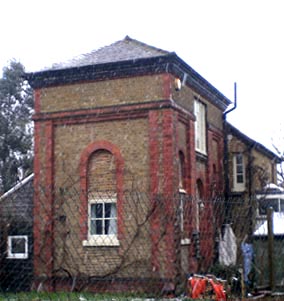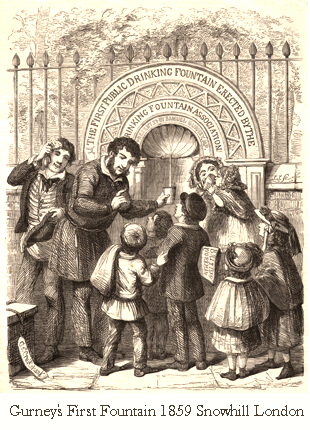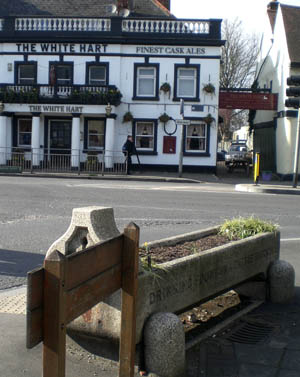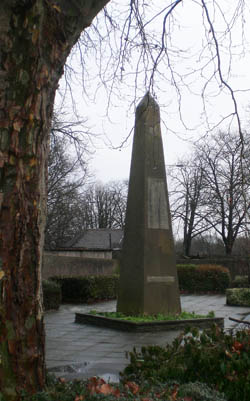Wilderness Island is where the Carshalton Wandle joins the Croydon Wandle. From here it snakes its way through Hackbridge and Morden before reaching the site of Merton Abbey and what is now known as Abbey Mills.

On large scale late 20th century maps, there is an artesian well shown close to the River Wandle at Carshalton. It lies on the southern side of the junction of Culvers Avenue with Green Wrythe Lane, behind the rows of houses. An artesian well is one that penetrates the aquifer and the pressure of water from the water table results in the well flowing without pumping assistance. Inspection of the site today reveals the brick building that is illustrated. This is the water tower over the well once providing gravity fed water from it's tank to the Culvers Estate including The Culvers (see below) the Limes and Culverside. Substantially built of decorative brickwork, its thick walls were necessary to support the weight of the tank. An original fireplace survives inside in the downstairs room, perhaps installed as a precaution against frost or to heat a room used by staff. The tower was built circa. 1875. When the Culvers Estate was sold in 1902 the facility was described as follows:
"The water supply for domestic and other purposes is obtained from an excellent Artesian Well (about 285' deep) situated in the western corner of the Park. The Well House is a Brick and Slated structure of neat elevation, containing a Patent Cycle Gas Engine (1 1/2 h.p.) by Atkinson, with double high pressure throw pumps by Hayward, Tyler and Co. and a Storage Tank (capable of holding up to 5000 gallons), which is connected by a three inch cast-iron service main which supplies by gravitation a 1,200 gallon tank in the roof of the Mill Premises." (source: Domestic Buildings Research Group (Surrey) 1979)
The well is now capped and its precise location uncertain. Extensions have been added to the tower in the latter part of the 20th century and it has been a domestic residence at least since the 1970s. It is now called Tower Cottage and enjoys a recently enlarged garden area.
The river and mills close by, down Culvers Avenue once flowed through the 280 acre Culvers Estate. Formerly it was owned in the nineteenth century by the Reynolds family, owners of one of the largest calico businesses in the world. The great Gurney banking family had married into the estate by the 1850s. MP Samuel Gu rney (1816 - 1882), a Quaker, introduced black swans here from Australasia. Gurney also built an impressive house 'The Culvers' in 1850 replacing an earlier building. The Metropolitan Drinking Fountain and Cattle Trough Association was set up by Samual Gurney and he was the instigator of a number of water facilities along the Wandle. For further details of these see Waddon Public House trough in the Croydon section and The Wrythe in the Carshalton section of this web site (click the water wheels below).
rney (1816 - 1882), a Quaker, introduced black swans here from Australasia. Gurney also built an impressive house 'The Culvers' in 1850 replacing an earlier building. The Metropolitan Drinking Fountain and Cattle Trough Association was set up by Samual Gurney and he was the instigator of a number of water facilities along the Wandle. For further details of these see Waddon Public House trough in the Croydon section and The Wrythe in the Carshalton section of this web site (click the water wheels below).
Samuel Gurney's father (also Samuel) died in 1856 and ten years later his financial institution, the Overend Gurney Bank, collapsed. The Culvers Estate was sold to Peter J Gassiot including the calico bleaching grounds. Thereafter the local calico business went into rapid decline.
John Peter Gassiot FRS (2 April 1797 - 15 August 1877) was an English businessman and amateur scientist. He was particularly associated with public demonstrations of electrical phenomena and the development of the Royal Society. He was very friendly with Michael Faraday and worked with him on research into electricity. The Wrythe Green Fountain in Carshalton, was the gift of J. P. Gassiot's family who bought the Culvers Estate in 1866. Here they lived and he was closely associated with Carshalton as a County Magistrate. Gassiot died at St John's, Ryde, Isle of Wight. His body lies in West Norwood Cemetery. When he retired his third son Charles (1826 - 1902) became head of the family business of Martinez, Gassiot & Co. wine merchants. Charles being unmarried, accumulated a substantial fortune and purchased a mansion Elmwood House, Upper Tooting. Both surviving sons, Charles and Sebastian died in 1902 and Charles was buried with his father in Norwood Cemetery. It is assumed that at this time the grant for the Wrythe Green Fountain was initiated from the estate proceeds. For more details see section 3 on the menu below.
The Culvers Estate came on the market again in 1902. Eventually the estate was broken up and sold for housing. The Culvers was pulled down in the 1960s.
For more details about the Association click the panel below.
MITCHAM GROTTOES
It was at Nonsuch Palace, in Surrey, that the Italianate ornamental grotto was first created as a garden feature. In the 16th century the Grove of Diana included a grotto that set the future fashion for grotto design in English stately homes. This Renaissance influence spread across England in subsequent centuries, with stately homes vying with each other to have the most astounding grotto in their grounds. Based on the mythology of the ancient Greeks and Romans, grottoes were a place of mystery and wonderment, created from natural materials where visitors could indulge in the fantasies of the ancients. Key ingredients to the grotto were a cave and a sacred spring with portrayals of gods and creatures that inspired the imagination.
Mitcham, located alongside the River Wandle between Hackbridge and Morden Hall, had its very own versions of the sacred grotto. This was not the elaborate creation of the stately home, but miniature grottos constructed by the children in the area as a means of raising money to fund a trip to the annual Fair on Fair Green. The structures the children produced at kerb sides were made of earth, shells, tawdry odds and ends of ribbons etc., bits of mirror or scraps of silver paper to represent water, and flowers 'borrowed' from local gardens. Grottos might be constructed on old trays so that they could be transported to more lucrative sites or moved swiftly out of sight of disapproving parents or adults likely to snitch. Passers-by were asked to give 'a penny for the grotto' so it paid for it to be as elaborate and decorative as possible. The tradition died out in the mid 20th century.
Click the crystal for more details of Mitcham's Grotto Day.
ARTESIAN SPRINGS IN THE WANDLE VALLEY
The foreboding obelisk now on the Mitcham cricket green dates from September 1822 and was erected by Reverend Richard Cranmer, Lord of the Manor, of Mitcham Canons to commemorate the finding of an artesian spring there after the dry summers of 1820/1. The following is the text on the stone plaque on the structure:
'In grateful recollection of the goodness of God through whose favour water has been provided for this neighbourhood. God opened the rock and water gushed out. They ran in dry places like a river. Psalm CV.V He turneth dry ground into water springs Psalm CVII V. 3.5. Let everything that have breath praise the Lord Psalm CLV A fountain shall water the valley' Also below on second stone plaque is the date 25th September 1822.
Cranmer was a descendant of the famous Thomas Cranmer, Archbishop of Canterbury for Henry VIII and leading light in the foundation of the Church of England, hence the biblical inscription.
Picture right - the obelisk at Mitcham.
In an article in Journal of the Society of Arts of 1877 it notes 'The Wandle valley presents a probably unique feature in the number of overflowing wells it contains. The oldest of these the public well near Tooting Church, was bored in 1822. Owing to the success of this boring another was bored by Mr Cranmer at a house called 'The Cannons' in September of the same year.'
The artesian wells of the London basin provided a major water source for the capital, the water table being pressurised by the overlying clays and any puncture of this resulted in water flowing to the surface.
A letter in The Mechanics Magazine of 1825 notes that not only was the well still flowing but that the Rev Cranmer actually had more than one well sunk. This account notes there were three, presumably separate wells bored on his land.
'To instance a few wells thus bored, - there is one on the coach road side at Tooting, five miles from Westminster Bridge, bored at the expense of the parish; and another at the same place on the premises of Mr Rolason, nurseryman, both abundant springs; there are three wells on the estate of the Rev. R. Cranmer, Mitcham Surrey and one on the premises of Messers. Holden, Coach Proprietors, Mitcham. At Merton, Surrey, eight miles from Westminster bridge ther are four wells bores, each casting up at least 50 gallons of water per minute and on my own land there is one well, which casts up nine gallons per minute.'
 Cranmer's well might well have been flowing in 1825 but it seems that the new water supply was short-lived. It is recorded that it went dry shortly after the erection of the obelisk on the Canons estate. As a result the obelisk was removed to a nearby street corner and the inscription eventually became illegible.
Cranmer's well might well have been flowing in 1825 but it seems that the new water supply was short-lived. It is recorded that it went dry shortly after the erection of the obelisk on the Canons estate. As a result the obelisk was removed to a nearby street corner and the inscription eventually became illegible.
Picture left - The horse trough on the Cricket Green, Mitcham. Dated from 1887 it celebrates Queen Victoria's Jubilee.



 Springs, Spouts, Fountains and Wells of the River Wandle - 5
Springs, Spouts, Fountains and Wells of the River Wandle - 5
 rney (1816 - 1882), a Quaker, introduced black swans here from Australasia. Gurney also built an impressive house 'The Culvers' in 1850 replacing an earlier building. The Metropolitan Drinking Fountain and Cattle Trough Association was set up by Samual Gurney and he was the instigator of a number of water facilities along the Wandle. For further details of these see Waddon Public House trough in the Croydon section and The Wrythe in the Carshalton section of this web site (click the water wheels below).
rney (1816 - 1882), a Quaker, introduced black swans here from Australasia. Gurney also built an impressive house 'The Culvers' in 1850 replacing an earlier building. The Metropolitan Drinking Fountain and Cattle Trough Association was set up by Samual Gurney and he was the instigator of a number of water facilities along the Wandle. For further details of these see Waddon Public House trough in the Croydon section and The Wrythe in the Carshalton section of this web site (click the water wheels below). 

 Cranmer's well might well have been flowing in 1825 but it seems that the new water supply was short-lived. It is recorded that it went dry shortly after the erection of the obelisk on the Canons estate. As a result the obelisk was removed to a nearby street corner and the inscription eventually became illegible.
Cranmer's well might well have been flowing in 1825 but it seems that the new water supply was short-lived. It is recorded that it went dry shortly after the erection of the obelisk on the Canons estate. As a result the obelisk was removed to a nearby street corner and the inscription eventually became illegible.




